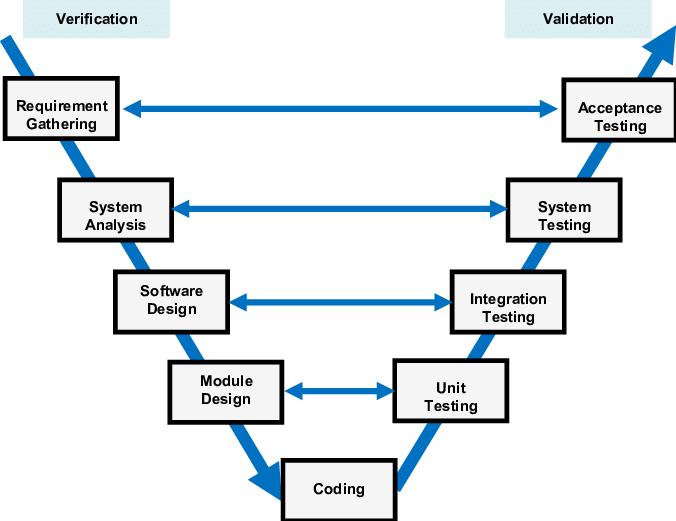In the realm of software development and quality assurance, having a well-structured approach is essential to ensure the reliability and functionality of software products. One such approach that has gained popularity in the software testing community is the V-Model. The V-Model, also known as the Verification and Validation Model, offers a structured and systematic way to perform software testing, starting from the earliest stages of development through to the final product. In this article, we will delve into the V-Model, its principles, and its advantages in software testing. If you’re seeking the best software testing training, understanding the V-Model is an essential component of your education.
Understanding the V-Model
The V-Model is a software development and testing framework that emphasizes the importance of verification and validation at each stage of the software development life cycle (SDLC). This model is called the “V-Model” because of its visual representation, which resembles the letter ‘V’ when diagrammed.
In the V-Model, the left side of the ‘V’ represents the development phase, while the right side represents the testing and validation phase. Each stage on the development side has a corresponding validation and testing stage on the right side, forming a symmetrical structure. This correlation between development and testing ensures that software is thoroughly examined and validated at every step of its creation.
Key Principles of the V-Model
- Sequential Phases: The V-Model promotes a sequential approach to software development and testing. It begins with the definition of requirements and proceeds through design, coding, testing, and deployment. This structured sequence helps identify and address issues early in the development process.
- Validation and Verification: The model emphasizes two crucial aspects: verification and validation. Verification ensures that the software is being built correctly according to the specified requirements. Validation, on the other hand, confirms that the software meets the customer’s expectations and needs. By considering both aspects, the V-Model enhances the likelihood of delivering a high-quality product.
- Parallel Development and Testing: As development activities progress on the left side of the ‘V,’ corresponding testing activities occur on the right side. This parallel approach allows for continuous feedback and immediate correction of issues, reducing the likelihood of defects being carried forward.
- Traceability: The V-Model stresses the importance of traceability, which means that each phase and component of the software must be traceable back to specific requirements. This ensures that no functionality is overlooked, and all requirements are met.
Stages of the V-Model
Let’s explore the key stages of the V-Model:
- Requirements Analysis: This initial phase involves gathering and analyzing user requirements. It lays the foundation for the entire development process and serves as a reference point for subsequent testing stages.
- System Design: During this phase, the high-level design of the system is created, outlining how the software will meet the requirements. It includes architectural design and module specifications.
- Module Design: In this stage, the design is broken down into smaller modules or components. These modules are developed independently, simplifying the testing process.
- Coding: The actual coding of the software takes place at this stage, where developers write the source code. Each module is coded and tested separately.
- Unit Testing: Unit testing is the first stage of testing and occurs at the module level. Each module is tested individually to ensure it functions correctly.
- Integration Testing: Modules are integrated to test how they interact with each other. This stage identifies issues related to module interactions and data flow.
- System Testing: The entire system is tested as a whole to ensure that it functions as intended and meets all requirements. This stage verifies the system’s overall functionality and reliability.
- User Acceptance Testing (UAT): UAT is the final stage, where the software is tested by end-users or stakeholders to validate that it meets their expectations and requirements.
- Deployment: Once the software successfully passes all testing phases and is approved in UAT, it is deployed to the production environment.
Benefits of the V-Model
The V-Model offers several advantages when it comes to software testing and development:
- Early Detection of Issues: By conducting testing in parallel with development, issues are identified and addressed early in the process, reducing the cost and effort required for later corrections.
- Improved Quality: The emphasis on both verification and validation ensures that the software meets specified requirements and customer expectations, leading to a higher-quality end product.
- Effective Communication: Traceability and clear documentation in the V-Model facilitate effective communication between development and testing teams, reducing misunderstandings and errors.
- Structured Approach: The V-Model provides a systematic and structured approach to software development, making it easier to manage and control the entire process.
- Reduced Risk: The V-Model’s systematic approach reduces the risk of critical issues going unnoticed, leading to a more robust and reliable software product.
Best Software Testing Training
If you’re interested in a career in software testing and quality assurance, it’s crucial to seek the best software testing training in Lucknow, Meerut, Noida, Delhi or other cities in India. A comprehensive training program will equip you with the skills and knowledge needed to excel in the field. Here are some key aspects to consider when looking for the best training:
- Comprehensive Curriculum: The training program should cover a wide range of testing techniques, methodologies, and tools, including the V-Model.
- Experienced Instructors: Look for training institutions with experienced instructors who have practical industry knowledge and can provide valuable insights.
- Hands-on Experience: Practical exercises and real-world projects should be part of the training to give you hands-on experience in using the V-Model and other testing methodologies.
- Certifications: Training programs that offer recognized certifications can boost your credibility in the job market.
- Placement Assistance: Consider programs that offer placement assistance to help you kick-start your career in software testing.
Conclusion
The V-Model is a structured approach to software testing that promotes early verification and validation, reducing the risk of defects in the final product. If you’re considering a career in software testing, understanding the V-Model is crucial. When seeking the best software testing training, ensure that the training program covers this model and provides you with the skills and knowledge to excel in the field. The V-Model, with its systematic approach, is a valuable tool for any software tester, ensuring the delivery of high-quality, reliable software products.
















